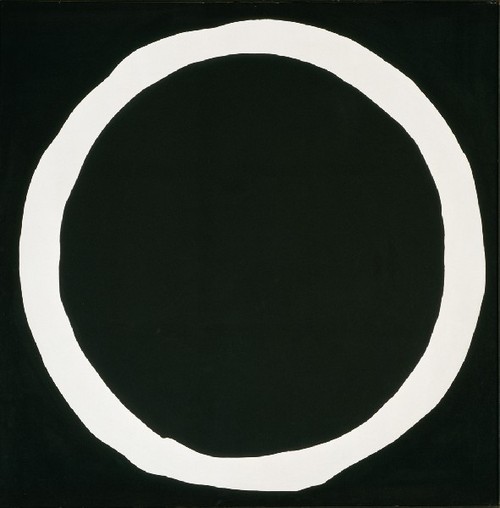
Jiro Yoshiharo
“Secularization is a nice technical word for this blankness. It means specialization and abstraction, social life driven by a calculus of large scale statistical chances, with everyone accepting or resenting a high level of risk; time and space turned into variables in that same calculus, both of them saturated by information and played with endlessly, monotonously on nets and screens…”
T.J. Clark
“Parametricism cannot become the long-term successor to Modernism because, like nearly all starchitecture, it ignores and exacerbates the urgent challenges of our time, such as the environmental crisis and the need to reintegrate ruptured urban fabric. Instead it is a perfect example of what Marshall McLuhan aptly termed a sunset effect, an exaggerated caricature of now obsolete characteristics of a waning era. Parametricism and icons exacerbate rather than solve the main failings of modern architecture, and not only because they are energy-profligate, anti-urban, stand-alone buildings that fail to define urban space and defy relationship with other buildings and humans.”
Peter Buchanan
“Jackson Pollock’s #12 is a big, brassy, gigolo of a painting; for the first time the aluminum paint looks like money, and the color is that of a sunset in a technicolor Western.”
Frank O’Hara
I think there is a connection between cooperation, as an idea (more on that below) and the ability to read narrative, to engage with it and in learning discrimination. In other words between art, the product of imagination, and the ability to work communally. Perhaps another way to say this is to echo what Walter Benjamin put forth (as a criticism of Kant) as ‘speculative experience’. This is the idea of a metaphysical grasp of art and culture. His example was color. And in a way it is the perfect example. No other conceptual subject so clearly distinguishes our primordial experience from the learned logics of visual perception. To look at the pink wall of a building in Mexico City is to experience something that we know by the label *pink*, but which is unique and ephemeral, even. It is simply not just *pink*. How much do we limit our experience of this pink on the wall by referring it, tacitly, to our learned definition of *pink*? That pink wall contains reflections of sunlight, the density and pressure of air, and it is, if one wanted to sit back a second and consider, perhaps closer to a blue we have experienced somewhere. On the sea, on in a blue sky in Scandanavia. Or perhaps closer to sounds and stories. But language demands certain appeals to definition. That is how language is built. For Benjamin, this idea of language led directly to *mimesis*. Benjamin said language (man’s language) is “a archive of nonsenuous similarities.”The idea of mimesis, for Benjamin, was based on mimicry. For him it was not just recognizing similarity, it was producing similarity. This is related to how children mimic the world, but more, it is related to Benjamin’s Kabbalistic ideas about nature and thought, but also it relates to his thinking on a sort of lost ability in humans to experience the world around them. The rise of instrumental thought and the ascension of a principle of cataloging and classification.
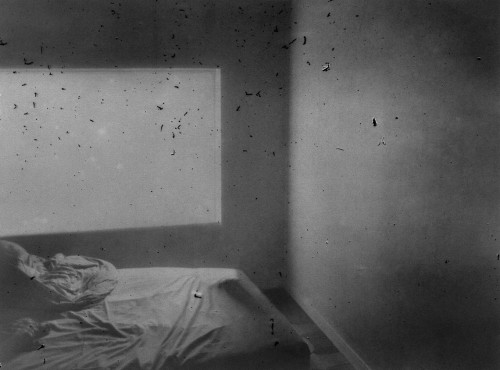
Daisuke Yokoto, photography.
This is of course also related to Kracauer and his idea of an imposition from above on what he termed ornament, but really meant all cultural production. In other words the experience of artworks was almost pre-arranged and limited by an increasingly restrictive sense of science. And not just science, but by extension the ways one arranges short hand or personal code for history and value. We have come to auto-classify. It also strikes me that this line of thinking, on language, but perhaps more, is the inverse of much Derridean post modernism. Today, in any event, the rise of technology has more fully eclipsed all tendencies of primordial mimetic production. A photograph of that pink wall and a later an exact duplication of that particular pink hue will not reproduce THAT *pink*, it create another pink, one distanced from our experience of the wall. Now, there is a built in ideological slant here that is part of a general doctrine of decline, of a technological decadence. And that is a dangerous indulgence. And it leads to a certain banality that can be found in a lot of new-age thinking.
T.J. Clark, in that quote at the top, sees what he calls this ‘cluster of features’, the rise of spread sheet thinking, as a direct result of capitalist accumulation and the spread of markets into all areas of human existence. Citing Adam Smith’s ‘hidden hand’, Clark decries the visible hiddenness that guides daily life, a surplus of nearly random information. And this sense of randomness and a feeling of blankness in social activity is the result, really, of capital more than technology per se. It is a form (per Clark) of blindness. I have written before of blindness in contemporary life (before reading Clark’s comments) and I think this is because it’s pervasive in our experience today. The endless onslaught of data and information, and accelerated now to an impossible degree, has caused a sort of mental vapor lock. A freeze of our experiences. Clark sees, rightly I believe, that modernism was the cultural response to this trend. To the rise of capital, or markets, of commodities. It was both expressing revulsion, but also was participating. And it is in the interstices of this tension between loathing and promise that a kind of anxiety was being expressed, an anxiety that has continued to intensify.
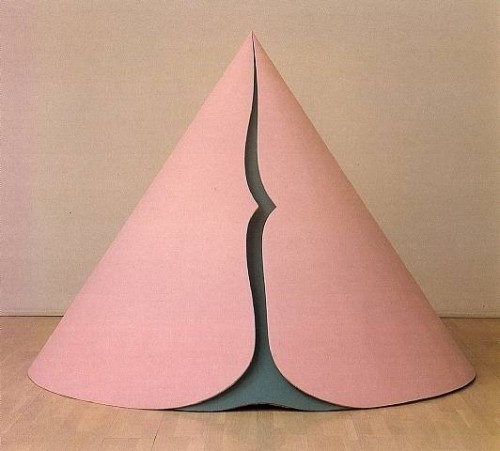
Philip King
That sense of collaboration or complicity is a theme in a number of works; from No Country for Old Men, to earlier, Thomas Mann, and Musil and in Handke’s first novels. But modernism was always oppositional to Capital, ultimately. Or at least it promosed a dream of anti-Capitalism, and struggled to deal with the cultural hostility in which much of the U.S. working class had been trained. For nobody in the U.S. has ever escaped the Puritanism and Protestant distrust of the frivolous. Art was also always perceived as too feminine. In any event, the rise of a society in which exchange value was stamped on everything, on consciousness, meant that the avant garde(s) of the early 20th century, through to mid-century, existed in this odd dynamic between that idealist promise, Utopian, and the increasingly drab and jejune underclass sensibility that found little to share with an art world under assault from Capital. But there is a contradiction of sorts at the heart of this, and it goes back, really, to 1793. Even there the role of money (Clark points this out) was instinctively connected with the very idea of representation. Bank notes and their valuation were reproduced, structurally, psychologically, in the 20th century — where the idea of signification de-facto privileges money, currency, coinage…the symbols or value, as having almost metaphysical significance. And losses of confidence run catastrophically deeper than mere loss of ‘things’. Even if those things are property. The post structuralist discourse, because of this focus on signs, seems a product, to some degree, of Capitalism.
But back to modernism and to Benjamin, and to an idea of art and narrative that is expansive and which inherently contains something that is to be shared. Contains desire as an experience that is fusion, is sharing, is that which cannot be happening in isolation. Benjamin was approaching mimesis from another direction than Adorno. This was mimicry — firstly, and so gesture, the ways in which humans learn to move, to walk, to run, when they are not following any written instructions. Or back to sight, where as Schwartz wrote…“By perception, Benjamin means experience that can go beyond the limits within which the natural sciences package the phenomenal world for knowledge; in particlar sight.”

Jonathan Charles, photography.
“The soul stands in intimate relation to the body, nourishing it and upholding it; it is below the first stirring. Having acquired due worth, it becomes the throne for the ‘spirit’ to rest upon, as it is written.”
Zohar, The Book of Splendor,
Kaballah (Scholem tr.)
Benjamin saw omens and presentments as valid bodily experience. For him, the human knew the future in his body. We humans had forgotten the language of Nature, and we experience a kind of guilt as a result. “Didn’t the dead person’s name, the last time you uttered it, already sound different in your mouth?”So, mimetic knowledge is a part of our amnesia, and a part of our sense of complicity. This theme is prevalent throughout modernist writing. An undifferentiated guilt. Both Benjamin and Dostoyevksi saw in playing cards a legitimate form of cardomancy. This is the allure of fortune tellers and spiritualists, and also the I Ching. Jung explored it, and so have countless writers of the 19th and 20th centuries. Jerry Mander wrote of his great Aunt, who wouldn’t let her grandchildren sleep in direct moonlight. When Benjamin points to the fact that knowledge comes too late for action, he sounds a lot like Wittgenstein, in an odd way. Wittgenstein when he tried to keep pointing out how language is about tacitly agreed upon games, and inches periously close to a form of behavior, he is not far off from Benjamin, who in reference to omens, says…“To interpret them or use them, that is the question.” And all of this is something that Adorno and Horkheimer discussed in terms of the promise of culture.
But gambling included another aspect, too. Benjamin saw the political in a bourgeois reproduction of rote labor. This is a form of experience that cannot be developed. The Monte Carlo fallacy (oddly a topic in an opening scene of my play Phantom Luck) is the truth of odds — that every flip of the coin is a new set of odds. And gambling, the addictive nature of gambling is akin to religious intoxication. The elevated state of mind, but elevated without an object. It is non analytic, finally. This is the truth of the pool game in The Hustler.The score is never indicated in that long sequence. Only the players playing. In sports, the term ‘in the zone’ (often used in basketball) indicating someone playing with extreme un-reflective confidence. Where, as one player put it, ‘the basket looks the size of giant tub.’ This is the knowledge of the body. And it is clear that the interests of Capital, especially as it appears in contemporary Western life, is to keep the people outside their body. Everything works toward this. Reification, that dynamic that manufactures an artifical intimacy with commodities. And worse, today, with abstract brands. Such identification is one linked, too, to obsessive compulsive behavior.
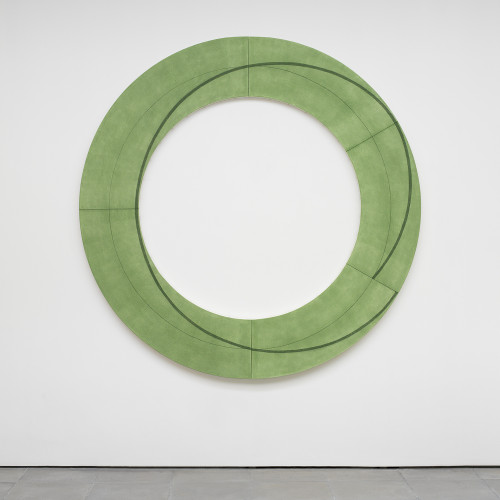
Robert Mangold
There is something in the alienated condition produced by Capitalism that interrupts a gestural openness. And this in turn creates a subtle web of anxieties. Adorno wrote; “In an all embracing system, conversation becomes ventriloquism.” He went on to say that language in its adaptation to a system of domination has resulted in matter and expression being severed. What he called ‘prepared mechanisms’ of speech had become attuned to situations and were brought out to, in a sense, replace real conversation. Today, it strikes me that almost all public discourse takes place in code, in short hand. Or, not even short hand, but in a sense by strategic counters. Public conversation, written and spoken, is competitive. Adorno pointed out, and this is almost sixty years ago, that there has occurred an obstinate insistence on being right (his words). This is that relationship to property, again. Arguments are owned, and defended. Adorno’s point was that such defending holds a tyrannical sway over the user. There is also, of course, links in such hyper-defending, to emotional insecurity. For men, the desire to appear the *owner* of what he knows. His knowledge becomes a kind of currency, of power. It is interesting how a wealthy man will pontificate about, well, anything, and assume his rightness, because it is decreed by the evidence of wealth. But I know very smart men, who compensate for lack of wealth or civic stature by weaponizng their knowledge. The result in both cases is something less than inclusion and cooperation. Again we return to anxiety. For this is an existential anxiety — one that, per Adorno, spreads a kind of rigor mortis through social interaction.
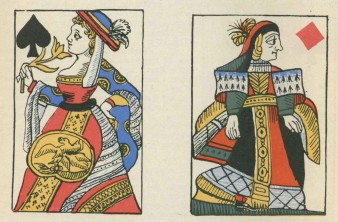
French Revolutionary playing cards, without crowns.
All of this is part of a growing fabric of punishment as a reflexive action. The body, what Benjamin explored in terms of a primordial mimetic knowledge, is now objectified, and branded, and often only capable of very basic reaction. And the reaction is aggressive. This aggressivity, which saturates contemporary Western culture, contains the residue of both Puritanism, and the ideology of Manifest Destiny. But it also sources a primary anxiety. And this is the most intractable and deeply ingrained aspect of it. But let me backtrack a bit here; for if early societies, those of 6000 B.C, had reached agricultural stability, a sudden eruption of inventiveness occurred. Pottery was being perfected and metallurgy was making its appearance, and there seemed a new social role was being occupied; that of technician, or craftsman. This the result of storable food, of surpluses even, that allowed developments in such things as weaving and basket making. It is impossible to know to what extent trade occurred, or war, but likely both. But what is of interest is that craftspeople, from the evidence available, were less highly regarded than scribes. Language was privileged over work of the hand. Andre Leroi-Gourhan sees this hierarchical division still at work, symbolically, in contemporary society. The man of action is heroic. The designer, less so. But the technician of signs, the scribe, holds a special place. Working with symbols, then, that primordial abandonment of mimetic knowledge, was fetishized. Today, the ‘coder’ is an interesting historical development that sort of draws upon both.

Ed Ruscha, photography. Laurel Canyon, North Hollywood 1967
The rise of metallurgy, the realm of Prometheus, becomes the Lord of civilization, however. The furnace arts eclipse all else. And that story is a fascinating one, but beyond the scope of this posting. Suffice it to say, the myths of Prometheus, of Cain and Able, were ambivalent. The furnace arts ushered in, likely, a new priest class, as well. The birth of the city, too. All brought ambivalence. The artisan’s continuing existence is then dependent upon the ruling classes, the aristocracy, the King and Queen. The pre-industrial city, the transitional period from artisanal to true Industrial, is a time of which anthropologists only guess at specifics. And no doubt this evolution varies from region to region. Raw materials, a reliable source of materials, shaped where and how stable were the various groupings. The point here, though, is that mimesis was not a contributing factor to development, per se. And yet, that collective memory was one that has been carried forward in myth and poem. Adorno, echoing Benjamin (and Werner) wrote; “With the sharp separation of science and poetry, the division of labor had already helped to effect took over language. The word was given to science as sign; while tone, as image, as true word it was divided among the arts…{} As sign, language is resigned to calculation in order to know nature, and must relinquish its claim to be similar to nature. As image, it is required to resign itself to copying in order to be all of nature, and must relinquish the claim to know nature.”
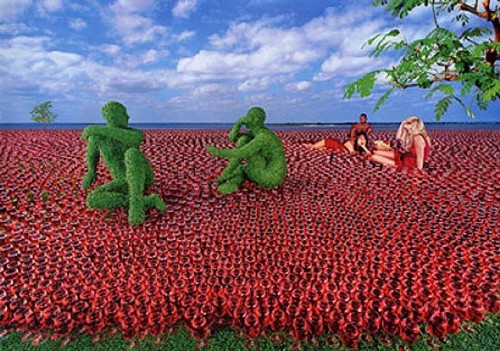
Sandy Skoglund
Adorno said art was a form of behavior. And this then brings us to the state of contemporary anti-mimesis. The relationships that primordial production of similarity shaped, are all now just distant memory. The only refuge (Adorno’s word) is in art. So, given a society that has waged war on art and culture, the better to imprint exchange value on experience, the refuge is now a lone silent individual monastery for the few. Contemporary society is all about eradicating refuges. The loss of audience for art, for artistic experience anyway, has resulted in a stultified and aggressive reaction formation in character. But this brings us back to *blindness*. And to Adorno’s notion of form.
“The sense of form is the reflection, at once blind and binding, of the work in itself on which that reflection must depend; it is objectivity closed to itself that devolves upon the subjective mimetic capacity, which for its part gains its force through its antithesis, rational construction.”
Adorno
As Frederic J. Schwartz observes, this is the capacity of art to produce forms that allow for the non-regressive breakdown of the difference between subject and object. But to do it non-regressively is the trick; for the hidden impulse is to always dominate (going back to early societies). The artwork is a riddle. But looking at how narrative intersects here, and modernism, and modernism’s revolt against instrumental rationality, the narrative must be more about keeping things out then letting things in. In theatre this has meant the avoidance of a representational stage. And of stories that resolve some superficial dilemma manufactured artificially by the play itself. The narrative must capture that color pink on the wall in Mexico City, not computer generate it, or *reproduce* it. What Schwartz calls its ‘artificial materiality’.
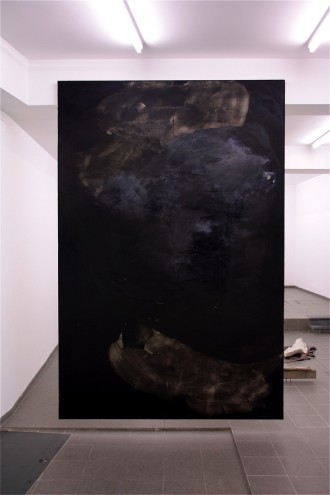
Lone Haugaard Madsen
The critical point, historically, for the loss of primacy of the corporeal body, was the mid 19th century. The technical, and with it a belief in classification, meshed with an expanding Capitalist modernity. Technics merged with the body, and questioned ideas of perception, especially the visual. And it brought with it, as Jonathan Crary puts it, a new regime of attentiveness. Industrialization created a new demand for a new kind of ‘attention’. The transcendental viewpoint of Kant was evaporating amid the vast upsurge of industrial fields of work, and of new optical instruments, and the change in managing labor that went from a paternalistic to an impersonal highly rationalized organization. The shape of *attention* changed, and with it came a new anxiety. Or rather an intensification of anxiety, again. Throughout this period there grew a new urgency about controlling not just attention (to make a better worker) but a new urgency to create comprehensive moral positions and categories for the public who were thrown into this new industrialized world.
“…attention implied an inevitable fragmentation of a visual field in which the unified and homogeneous coherence of classical models of vision were impossible. The camera obscura model of vision in the 18th century described an ideal relation of self-[resence between observer and world. Attention as a process of selection necessarily meant that perception was an activity of exclusion, of rendering parts of a perceptual field unperceived.”
Jonathan Crary

Banks Violette, installation.
I wrote last time of contemporary ‘hyper solicitation’ (Katheryn Hales’ term). The birth of this solicitation coincided with, or perhaps largely created by, the birth of cinema. Tom Gunning (quoted by Crary) suggested early film was the first time performers openly flaunted their visibility — looking to capture the attention of the audience. An audience not in the room. The telegraph, developed and put into use in the 1840s introduced anonymous sourced information. The idea of context changed. That may be the most significant aspect of all these changes. The subject no longer could know the context of the information he or she was exposed to, and was meant to interpret. By the early 20th century, with the advent of psychoanlysis, the questions of mimetic engagement centered around a subjectivity that was attempting to forge new concepts of position, of space, for memory. How one remembered in 1700 was not the same as how one remembers in 2015. The broad brush over view then is that institutional organizations of power, of Capitalist controls for labor, changed as new technologies appeared, and with them, new moral justifications for control. As Crary points out, today the new classifications of ADHD are rationalizations of control. The unruly masses must be pacified and under cover of *concern*. The truth is that ADHD and ADD are phantom conditions. They are categories of control and discipline. Attention means attention to what the institutions of domination want you to attend to, and divergence is not just a failure to do your job, but now, a sickness. And illness is consistent with the formation of a new liberal idea of responsibility. Society is a parent who must look out for badly behaving children.

Lina Bo Bardi, architect. Museum on the Beach, Brazil. 1951
Today, the obvious similarities between factory farming of animals, and public schools cant be lost on everyone. Or the reality of mass incarceration in the U.S. The industrial level of control, de-contextualized, has left the mimetic in a highly reduced role. Entertainment is hyper solicitation, has merged with marketing and advertising. The popularity of Mad Men speaks to its role as almost a foundation myth for contemporary consciousness. Modernism was, in various ways and forms, responding to these forces of control. And it was responding to shifts in how attention was being conceptualized. In that sense, I’ve thought the standard idea of a pre-modern wholeness that was disturbed by various processes and forces of fragmentation, to be too one dimensional. For while that is true, to some degree, it is also true, that modernist art was working to express primordial physiognomic mimetic experience, to reclaim rather than to just present evidence of decay. Today’s culture is one of distraction, but also of capture. Of coercion. Resistance to distraction is found in, again, art practice that works around its own expression to keep free of the ever widening net of capture that electronic media and telecom hegemony. Mass culture is omnipresent, and the focus on Autism is suggestive of an adaptive change in processing this surplus de-contextualized sensory stimuli.
Distraction for Crary is an effect, not an interruption, and I think this is right. It is certainly, in contemporary Western society an effect of the countless forms of attention grabbing solicitations in screen media. Attention, though, has lost its intersubjectivity. The communal in material terms is under assault, and increasingly seen by the ruling class as a threat. The hordes must be kept fragmented, both physically, and mentally. The manufacture of attention is really the manufacture of a limited contained attention. A non-reflective attention. The erosion of the audience for theatre has to do with its communal group focus. Cinema is experienced more passively, but the danger there is one of a dream state. The dream is too memory based, hence today’s output from Hollywood is unrelentingly kinetic and the duration of individual scenes grows ever shorter. It is a cinema of ADHD, which is only one of the many contradictions in play. The point here is that an experience that directs the individual toward aesthetic reflection, toward mimetic memory and recreation, is an art of resistance, today. But that means, strategically, that much is to be kept out. Facile moralizing, or middle brow familiarity — a sort of Pollyanna-esque positivity is be eschewed, as is the hyper sadistic titillation of most Hollywood film. The physiognomic is substituted by an endless presentation of body as sexual prey. Mostly this means women as objects for hunting and metaphoric taxidermy. The real memory of the body, mimetically, is found in non-classified experience. The pink wall, again. The pink wall is not pink. It is allegorical pink. A forgotten encounter with something, elusive and singular. Cooperation is an attentiveness to community, not acquisition of skills that apply to technics, or the constant attention to the self’s brand. The anti-human quality is the Capitalist effect, an anti cooperative distance, automaton like. The fascist of today is no less attracted to the *volkish*, but additionally is more acutely tuned to commands…implicit or explicit. The reading of cues is the new supreme sign of accommodation to authority. Commands are now without context, anonymous often, and part of a stream of information that is reacted to, internalized, and stored away. Read the cues. Adopt the message.
If one wants to see the side of Modernism, in architecture, that represented resistance, then Italian/Brazilian Lina Bo Bardi is worth getting to know. I add this as a kind of addendum, though I’d like to write a good deal more about her work. An architect, political activist, social theorist, theatre designer and curator of museums, Bo Bardi was almost the opposite of what Peter Buchanan has labled ‘starchitect’. Her work is the opposite of all that today’s mammoth economic icon projects imply. She, like Ludwig Leo, was both of her time, and not of it. For once the rhetoric of putting people first was not just empty press posturing, it was the center of her understanding of building. Modernism was, as I say, in many places, a Utopian and anti-Capitalist vision.
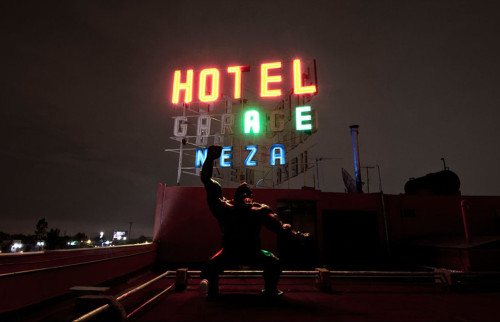
Arturo Garcia, photography. (Nezahualcoyotl, Mexico)
I wanted to comment on the death this last week of Ornette Coleman. I had the good fortune to meet Ornette once, and spend the day with him. This was in the early 70s, in NYC. He was patient with my confused questions, but he never was anything less than gracious and generous. He was also a perfect example of a kind of curiosity that one rarely finds anymore. Coleman’s breakout record came in 1959; “The Shape of Jazz to Come”. I remember the first time I heard it. I loved it. I didn’t know why, but I did. I remember smiling the whole time I was listening to it. I couldn’t stop smiling. My old friend Bill Larstead was with me, and we were both still in high school and the record was ten years old then. We’d look at each other every few minutes and smile. This was it, this was some serious shit. That much we knew. There was too much conviction, too much knowledge, too much purity. What you have to understand about Ornette was that he was from Texas. He stayed a southerner, too. In spite of living most of his life in New York City. His came out of Texas R&B, out of a sound on saxophone normally associated with Illinois Jacquet or Fathead Newman. And it’s linked in its way to Jimi Hendrix, too. That R&B background. And of course Cecil Taylor was the other great originator. Ornette’s best record, for me anyway, was New York is Now, recorded in 1968. His influence was huge. Anthony Braxton was helped a lot by Ornette, and that’s how I met him that summer day. He was curious and he loved instruments, of any kind. He loved to listen to weird stuff, Thai lounge music, say, and he looked at the classical traditions of Indian and Japanese music. He just dug the idea of people playing together. He was that rare thing today, an artist.

Ornette Coleman

Speak Your Mind